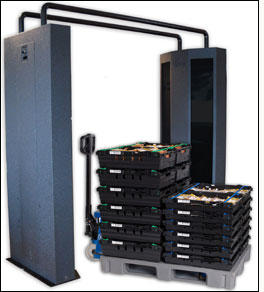Norsk Lastbærer Pool (NLP)—an organization established by Norwegian consumer goods manufacturers and retailers to manage a nationwide pool of pallets—is transitioning Norway’s consumer goods sector to RFID-tagged plastic pallets and totes, leased by NLP, each with EPC Gen 2 ultrahigh-frequency (UHF) RFID tags. In February 2011, as part of that transition, the organization intends to pilot the use of RFID handheld readers and fixed reader portals at the factories of snack-food company Maarud and sausage producer Finsbråten, as well as at two distribution centers for retail chain Coop.
NLP was established in 2006 as an organization for reducing the environmental footprint of the logistics operations within the Norwegian fast-moving consumer goods (FMCG) supply chain. The RFID pilot is being managed by Hrafn (the Norse word for raven, symbolizing the two birds of Odin), an RFID consultancy and the pilot’s chief architect. The RFID infrastructure includes fixed readers provided by Impinj, antennas from Intermec and handheld readers supplied by Nordic ID, as well as Tag Acquisition Processor (TAP) middleware from Reva Systems. Hrafn is also hosting Electronic Produce Code Information Services (EPCIS) software used to store RFID data and make it available to supply chain participants, employing the open-source EPCIS software known as Fosstrak (see Open-Source EPCIS Catching On). Lexit Group is installing and integrating the hardware and providing software that links a user’s back-end information, such as the order number and ship-to-location Global Location Number (GLN) code, with the pallets’ tag ID numbers, while Telenor Ojects‘ Shepherd platform links data from read events to the EPCIS software, while also providing hardware monitoring by detecting errors such as connectivity problems with a reader or antennas out of service.
At present, approximately 150,000 of NLP’s tagged plastic pallets are already in use by Norwegian FMCG companies, though until now, none have had the RFID infrastructure necessary to read the pallets’ RFID tags. During the pilot, expected to run until May of this year, participating companies will track when the tagged pallets are packed, shipped, received at distribution centers and shipped again to retailers. All data is being shared between NLP and its supply chain partners, through the use of EPCIS software.
The participants hope the pilot technology will convince consumer goods companies that there is a business case for RFID. At that point, NLP will provide a standardized RFID infrastructure package suitable for any of the approximately 800 facilities in Norway’s consumer goods supply chain, including warehouses, DCs and retail stores.
Within the next few years, NLP expects its pool of RFID-tagged plastic pallets and totes to grow to 6 million. Currently, the Norwegian FMCG market moves $28 billion annually on 7 million pallet trips, using a pool of approximately 1.8 million untagged wooden pallets. With plastic pallets, goods shipments will be lighter, and will thus require less fuel for transport. By using RFID tags, participants throughout the supply chain will be encouraged to track data regarding the products loaded onto the pallets. The pilot is intended to demonstrate that pallets can be read in real-world environments, and to prove the business case for tracking pallets as they are shipped or received. For pallet users, visibility helps to ensure that they not keep the pallets in storage any longer than necessary, thereby reducing their leasing fees.
Beginning in February, NLP also plans to start utilizing the RFID technology within its own operations, at the organization’s washing and repair station. Pallets will pass through RFID portals upon entering and exiting the facility. Pallet repairs will be recorded by means of handheld readers to input and store information about each repair, says Geir Vevle, Hrafn’s CTO. NLP will also employ RFID to charge pallet users the appropriate rental and handling fees, since RFID readers will record the exact time that a pallet entered or left a particular facility. The ROI derived from the ability to automatically record the arriving and departing pallets, Vevle says—instead of a manual process, which can often be as inaccurate as 1 to 5 percent—enables the RFID infrastructure to pay for itself immediately.
Each of a plastic pallet’s four corners is fitted with an embedded UPM Raflatac Short Dipole tag with 240 bits of EPC memory and an additional 512 bits of user memory. When the pallets at Maarud or Finsbråten are loaded with goods destined for either of the two RFID-enabled Coop DCs, the company’s staff utilizes handheld readers to interrogate the tags and then encode the shipping order number onto the tag, along with the load’s destination. The handhelds, either through a Wi-Fi connection or a cradle plugged into a PC, transmit the ID number linked to the shipping details to the company’s back-end system, as well as the EPCIS software in which it is stored and displayed for those who wish to access the data via the Internet. As the loaded pallets are moved onto trucks, they will first pass through a reader portal designed by Hrafn, and provided and installed by Lexit Group. The portal will read each pallet’s tag, confirming that the goods are being shipped, and forward that information to the Fosstrak software.
When the pallets arrive at the Coop distribution center, another Hrafn portal will read the tags’ data, including each pallet’s unique ID number, shipping code and destination, and then send that information to Coop’s own EPCIS repository software, accessible to other supply chain members via the Internet. When the DC ships pallets of goods to a store, the tags will be read a final time as the pallets are loaded onto a truck.
If all goes as planned, the RFID pallet pilot will provide consumer goods companies with proof that the technology offers benefits to the supply chain. “Both previous RFID pilots and our customers’ reactions have shown us a gap between expectations and the reality behind the technology,” says Thomas Skjøldt, Lexit Group Norway’s sales manager. “In order to commercialize our RFID package, we have learned that it is important to deliver simple, transparent solutions with a simple and understandable ROI model.”
The pilot will track only the movements of the pallets themselves, though the next step, according to Tom Romanich, NLP’s IT business development manager, will involve developing software enabling users to link the pallets with the actual goods loaded onto them, thereby tracking the product’s movements. By sharing this data between suppliers and retailers, Vevle says, “This will make both receiving and dispatching more efficient and more accurate.”
While supply chain members purchased their own wooden pallets in the past, Romanich says, the plastic pallets can be leased from NLP for an annual cost of about $10. For those wishing to use the RFID tags, the firm will provide the necessary reader infrastructure and charge a service fee, according to the number of transactions.
The RFID infrastructure package to be offered by NLP will also contain an educational program being developed by Hrafn and GS1 Norway, designed to enable users to accrue even more benefits from the use of RFID. “By raising the knowledge of CEOs, supply chain managers and others, we expect the impact on the whole chain to be breathtaking,” Vevle states.
In addition to tagging plastic pallets, NLP has begun attaching EPC Gen 2 RFID tags from Alien Technology to the plastic Maxinest produce trays that it rents to customers, in order to increase visibility within the supply chain. NLP currently has approximately 80,000 such RFID-enabled trays, provided by Linpac Allibert. Each tray has been fitted with two embedded tags with 240 bits of EPC memory and 512 bits of user memory, encoded with such data as supplier details, customer location, and washing and delivery schedules at a distribution center. The tags’ data can then be accessed at RFID portals, or via a handheld reader.
Before the RFID-enabled trays are being palletized and shipped to customers, NLP uses then individually validated by a test reader. A palletload of trays is then passed through a portal, which records quantity and verifies that the tags are properly functioning. Customers receive the tag ID numbers by e-mail for upload onto their system, so that they can use RFID to instantly check the quantity upon delivery.




